
Concept explainers
To find: What is the maximum volume of the cylinder?
The volume of cylinder as a function of h would be V=π4(256h−h3) . The value of h would be approximately 9.24 . The maximum volume of the cylinder is about 1238 cubic units.
Given information:
A cylinder is inscribed in a sphere of radius 8.
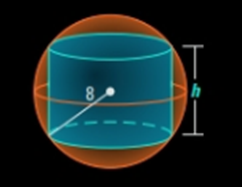
Formula used:
Volume of cylinder is πr2h , here r represents radius and h represents height of the cylinder.
Calculation:
First of all, find the radius of cylinder using Pythagoras theorem. Draw a right triangle as shown below:
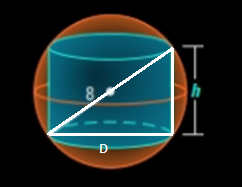
Here D is diameter of the cylinder. Using Pythagoras theorem, the set-up would be:
D2=(8+8)2−h2D2=162−h2D2=256−h2D=√256−h2
It is known that radius is half the diameter, so radius of the cylinder would be r=√256−h22 .
V=πr2h=π(√256−h22)2h=πh(256−h24)=π4(256h−h3)
Therefore, the volume of cylinder as a function of h would be V=π4(256h−h3) .
Upon graphing the volume function, the required graph would look like as shown below:
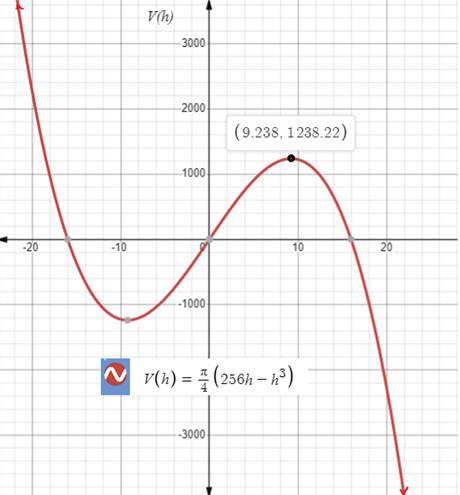
It is visible that the maximum volume is about 1238 cubic units and occurs when x≈9.238 , therefore, the value of h that maximizes the volume would be 9.24 units.
Chapter 2 Solutions
Algebra 2: New York Edition (holt Mcdougal Larson Algebra 2)
- 4) A researcher gathered data on the amount of time students spent studying per week. Given the following frequency distribution, fill in the relative and cumulative frequency. Hours per week: at least Frequency Relative Frequency Cumulative Relative Frequency 0 but less than 2 4 2 but less than 4 15 4 but less than 6 41 6 but less than 8 20 8 but less than 10 7 10 or more 3 a) What percentage of students study less than 6 hours per week?arrow_forwardoptions are greater than less than or about the same asarrow_forwardA candy machine contains over \[1{,}000\] pieces of candy, \[30\%\] of which are blue. Customers get an SRS of \[15\] candies in a purchase. Let \[X=\] the number of blue candies that a random customer gets in a purchase. Find the mean and standard deviation of \[X\].You may round your answers to the nearest tenth.arrow_forward
- A television show tests the abilities of alleged psychics by presenting contestants with a set of \[4\] cards placed upside down, \[1\] of which has a star printed on it. Each contestant attempts to identify which card has the star on it for a series of \[50\] trials. Assuming that the contestants are purely guessing, what are the mean and standard deviation of the number of trials where the contestant guesses correctly?You may round your answers to the nearest tenth.arrow_forwardA television show tests the abilities of alleged psychics by presenting contestants with a set of \[4\] cards placed upside down, \[1\] of which has a star printed on it. Each contestant attempts to identify which card has the star on it for a series of \[50\] trials. Assuming that the contestants are purely guessing, what are the mean and standard deviation of the number of trials where the contestant guesses correctly?You may round your answers to the nearest tenth.arrow_forwardA large fast-food chain runs a promotion where \[1\]-in-\[4\] boxes of french fries include a coupon for a free box of french fries. Suppose that some location sells \[100\] of these boxes of fries per day. Let \[X=\] the number of coupons won per day. Find the mean and standard deviation of \[X\].You may round your answers to the nearest tenth.arrow_forward
- A roulette wheel has \[38\] slots, of which \[18\] are red, \[18\] are black, and \[2\] are green. In each round of the game, a ball is tossed in the spinning wheel and lands in a random slot. Suppose we watch \[7\] rounds of this game, and let \[R\] represent the number of rounds where the ball lands in a red slot. Which of the following would find \[P(R=3)\]?arrow_forwardA small college has 800students, 10% of which are left-handed. Suppose they take an SRS of 8students. Let [L=] the number of left-handed students in the sample. Which of the following would find [P(L=2)]?arrow_forward[2 01 3. (12 pts) Let A = 1 1 and b = 1 L2 1] 213 [2] (1) (2) Use the Gram-Schmidt process to find an orthonormal basis for the column space of A. Factor A into a product QR, where Q has an orthonormal set of column vectors and R is upper triangular. (3) Solve the least squares problem Ax = b.arrow_forward
- 22.) Mr. Vedrani has a pool with a deck built around it. The equation (2x+14)(2x+19) = 650 represents the relationship of the side lengths (in feet) of the entire pool area (in square feet). a.) If 350 represents the area of the pool and deck area, what do the expressions (2x+14) and (2x+19) each represent? b.) Using graphing technology, find x, the width of the deck around the pool. If necessary, round to the nearest tenth. x=arrow_forwardHow do I get common factors?arrow_forwardProblem #1 You apply to two different graduate programs at a specific university: one in geology and one in environmental sciences. Let P(G) = 0.8, where P(G) represents the probability that you get accepted into the geology program. Let P(E) = 0.72, where P(E) represents the probability that you get accepted into the environmental sciences program. Let P(GE) = 0.65. a). Create a Venn diagram that represents this information. b). First, calculate P(GUE). Then, using complete sentence, interpret what P(GUE) represents in the context of this problem.arrow_forward
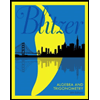 Algebra and Trigonometry (6th Edition)AlgebraISBN:9780134463216Author:Robert F. BlitzerPublisher:PEARSON
Algebra and Trigonometry (6th Edition)AlgebraISBN:9780134463216Author:Robert F. BlitzerPublisher:PEARSON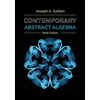 Contemporary Abstract AlgebraAlgebraISBN:9781305657960Author:Joseph GallianPublisher:Cengage Learning
Contemporary Abstract AlgebraAlgebraISBN:9781305657960Author:Joseph GallianPublisher:Cengage Learning Linear Algebra: A Modern IntroductionAlgebraISBN:9781285463247Author:David PoolePublisher:Cengage Learning
Linear Algebra: A Modern IntroductionAlgebraISBN:9781285463247Author:David PoolePublisher:Cengage Learning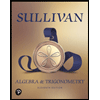 Algebra And Trigonometry (11th Edition)AlgebraISBN:9780135163078Author:Michael SullivanPublisher:PEARSON
Algebra And Trigonometry (11th Edition)AlgebraISBN:9780135163078Author:Michael SullivanPublisher:PEARSON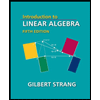 Introduction to Linear Algebra, Fifth EditionAlgebraISBN:9780980232776Author:Gilbert StrangPublisher:Wellesley-Cambridge Press
Introduction to Linear Algebra, Fifth EditionAlgebraISBN:9780980232776Author:Gilbert StrangPublisher:Wellesley-Cambridge Press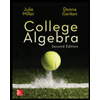 College Algebra (Collegiate Math)AlgebraISBN:9780077836344Author:Julie Miller, Donna GerkenPublisher:McGraw-Hill Education
College Algebra (Collegiate Math)AlgebraISBN:9780077836344Author:Julie Miller, Donna GerkenPublisher:McGraw-Hill Education





